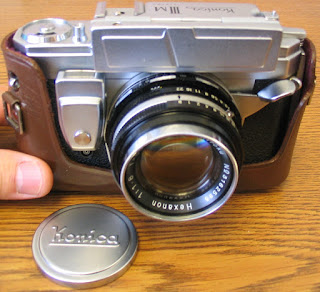When shooting with a body without AF and split-image focusing screen or in low light, this device will be much helpful. It's great for portrait, not for sport or fast-moving objects, because you may need to flip up the magnifier to compose your image.
Without the adapter, the magnifier can be screwed on the round frame of viewfinder on Konica bodies like Auto-Reflex.
With the adapter, the magnifier can be used with Konica cameras with a square frame of viewfinder, such as FT-1.
I got my set in its original box. I guess, it was first sold at JPY 3500 in Japan, as marked on the price tag. The number on the cover sticker should be the part #.













































